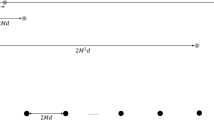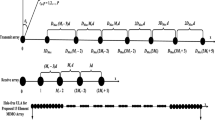Abstract
As a sparse array, coprime array with application to multiple-input multiple-output (MIMO) radar can provide more resolvable targets than uniform linear array. In this study, we address joint direction-of-departure (DOD) and direction-of-arrival (DOA) estimation in a bistatic MIMO radar with coprime transmitting and coprime receiving arrays. First, the signal model is established, in which the residual error between the sample and statistical covariance matrices is considered. Then, a permutation matrix is constructed to form the virtual difference coarrays with respect to both transmitting and receiving coprime arrays, and two average operators are designed to average the repeated elements in the transmitting and receiving coarrays, respectively. Since the coarrays are inconsecutive and have holes which prevent us from fully utilizing the entire virtual aperture, an interpolation algorithm via decoupled atomic norm minimization (DANM) is presented to fill the holes and achieve the enhanced degrees of freedom (DOFs). The DANM is recast into a semi-definite programming (SDP) problem with the considered residual error, and a specific alternating direction method of multipliers (ADMM) is developed to solve such a SDP problem with high computational efficiency. Numerical simulations demonstrate that it can achieve more DOFs than several existing methods in bistatic coprime MIMO radar.








Similar content being viewed by others
Explore related subjects
Discover the latest articles, news and stories from top researchers in related subjects.Data availability
Data sharing not applicable to this article as no datasets were generated or analysed during the current study.
References
Abramovich, Y. I., Spencer, N. K., & Gorokhov, A. Y. (1999). Positive-definite Toeplitz completion in DOA estimation for nonuniform linear antenna arrays. II. Partially augmentable arrays. IEEE Transactions on Signal Processing, 47(6), 1502–1521.
Boyd, S., Parikh, N., Chu, E., Peleato, B., & Eckstein, J. (2011). Distributed optimization and statistical learning via the alternating direction method of multipliers. Foundations and Trends in Machine Learning, 3(1), 1–122.
Chen, D., Chen, B., & Qin, G. (2008). Angle estimation using ESPRIT in MIMO radar. Electronics Letters, 44(12), 770–771.
Chen, F., Zheng, J., & Dai, J. (2018). DOD and DOA estimation for bistatic MIMO radars with sparse Bayesian learning. In Int. Works. Antenna Tech. (iWAT), Nanjing, China (pp. 1–4).
Donoho, D. L. (2006). Compressed sensing. IEEE Transactions on Information Theory, 52(4), 1289–1306.
Ender, J. (2013). A brief review of compressive sensing applied to radar. In Int. Radar Sym. (IRS), Dresden, Germany (pp. 3–16).
Fishler, E., Haimovich, A., Blum, R., Chizhik, D., Cimini, L., & Valenzuela, R. (2004). MIMO radar: An idea whose time has come. In IEEE Radar Conf., Hawaii, USA (pp. 71–78).
Fu, M., Zheng, Z., Wang, W.-Q., & So, H. C. (2021). Coarray interpolation for DOA estimation using coprime EMVS array. IEEE Signal Processing Letters, 28, 548–552.
Guo, Y., & Gong, J. (2021). Low observable group targets detection based on space frequency cascaded adaptive processing for MIMO OTH radar. Multidimensional Systems and Signal Processing, 32, 1005–1026.
Jia, Y., Zhong, X., Guo, Y., & Huo, W. (2017). DOA and DOD estimation based on bistatic MIMO radar with co-prime array. In IEEE Radar Conf. (RadarConf), Seattle, WA, USA (pp. 0394–0397).
Jiang, H., Qi, H., & Yao, S. (2017). Direction finding of multiple targets using coprime array in MIMO Radar. IEICE Communications Express, 6(3), 115–119.
Jinli, C., Hong, G., & Weimin, S. (2008). Angle estimation using ESPRIT without pairing in MIMO radar. Electronics Letters, 44(24), 1422–1423.
Krishnan, K., & Terlaky, T. (2005). Interior point and semidefinite approaches in combinatorial optimization. In Graph theory Comb. Optim. (pp. 101–157). Springer.
Li, J., & Stoica, P. (2009). MIMO radar diversity means superiority. In IEEE MIMO radar signal processing (pp. 1–64).
Li, J., He, L., He, Y., & Zhang, X. (2019a). Joint direction of arrival estimation and array calibration for coprime MIMO radar. Digital Signal processing, 94, 67–74.
Li, J., Jiang, D., & Zhang, F. (2017). DOA estimation based on combined unitary ESPRIT for coprime MIMO radar. IEEE Communications Letters, 21(1), 96–99.
Li, J., & Stoica, P. (2007). MIMO radar with colocated antennas. IEEE Signal Processing Magazine, 24(5), 106–114.
Li, Z., Zhou, C., Jia, Y., Wang, G., Yan, C., & Lv, Y. (2019b). DOD and DOA estimation for bistatic co-prime MIMO array based on correlation matrix augmentation. In Int. Conf. Control, Autom. Inf. Sci. (ICCAIS), Chengdu, China (pp. 1–5).
Liu, C., Vaidyanathan, P. P., & Pal, P. (2016). Coprime coarray interpolation for DOA estimation via nuclear norm minimization. In Q. C. Montreal (Ed.), IEEE ISCAS, Canada (pp. 2639–2642).
Moffet, A. (1968). Minimum-redundancy linear arrays. IEEE Transactions on Antennas and Propagation, 16, 17–175.
Ottersten, B., Stoica, P., & Roy, R. (1998). Covariance matching estimation techniques for array signal processing applications. Digital Signal Processing, 8(3), 185–210.
Pal, P., & Vaidyanathan, P. P. (2010). Nested array: A novel approach to array processing with enhanced degree of freedom. IEEE Transactions on Signal Processing, 58(8), 4167–4181.
Qiao, H., & Pal, P. (2017). Unified analysis of co-array interpolation for direction-of-arrival estimation. In 2017 IEEE international conference on acoustics, speech and signal processing (ICASSP) (pp. 3056–3060).
Qiao, H., & Pal, P. (2019). Guaranteed localization of more sources than sensors with finite snapshots in multiple measurement vector models using difference co-arrays. IEEE Transactions on Signal Processing, 67(22), 5715–5729.
Qin, S., Zhang, Y. D., & Amina, M. G. (2017). DOA estimation of mixed coherent and uncorrelated targets exploiting coprime MIMO radar. Digital Signal Processing, 61, 26–34.
Roy, R., & Kailath, T. (1989). ESPRIT-estimation of signal parameters via rotational invariance techniques. IEEE Transactions on Acoustics, Speech, and Signal Processing, 37(7), 984–995.
Sheng, G., Wang, H., Wen, F., & Wang, X. (2020). Fast angle estimation and sensor self-calibration in bistatic MIMO radar with gain-phase errors and spatially colored noise. IEEE Access, 8, 123701–123710.
Shi, J., Hu, G., Zhang, X., Sun, F., Zheng, W., & Xiao, Y. (2018). Generalized coprime MIMO radars for DOA estimation with enhanced degrees of freedom. IEEE Sensors Journal, 18(3), 1203–1212.
Shi, J., Hu, G., Zhang, X., & Sun, F. (2019). Sparsity-based DOA estimation of coherent and uncorrelated targets with flexible MIMO radar. IEEE Transactions on Vehicular Technology, 68(6), 5835–5848.
Shi, J., Wu, D., Li, Z., & Wen, F. (2020). Tensor-based angle estimation with coprime MIMO radar. In IEEE SAM, Hangzhou, China (pp. 1–4).
Swerling, P. (1960). Probability of detection for fluctuating targets. IRE Transactions on Information Theory, 6(2), 269–308.
Tang, G., Bhaskar, B. N., Shah, P., & Recht, B. (2013). Compressed sensing off the grid. IEEE Transactions on Information Theory, 59(11), 7465–7490.
Tang, W.-G., Jiang, H., & Pang, S.-X. (2019a). Coprime array interpolation for direction of arrival estimation based on atomic norm minimization. In IEEE Radar Conf. (RadarConf), Boston, MA, USA (pp. 1–5).
Tang, W.-G., Jiang, H., & Pang, S. (2019b). Gridless angle and range estimation for FDA-MIMO radar based on decoupled atomic norm minimization. In 2019 IEEE international conference on acoustics, speech and signal processing (ICASSP), Brighton, UK (pp. 1–5).
Tang, W.-G., Jiang, H., & Zhang, Q. (2019c). ADMM for gridless DOD and DOA estimation in bistatic MIMO radar based on decoupled atomic norm minimization with one snapshot. In IEEE Glob. Conf. Signal Inf. Process. (GlobalSIP), Ottawa, ON, Canada (pp. 1–5).
Tang, W.-G., Jiang, H., & Zhang, Q. (2021). Gridless DOD and DOA estimation in bistatic MIMO radar using 2D-ANM and its low complexity algorithms. Digital Signal Processing, 108.
Tian, Z., Zhang, Z., & Wang, Y. (2017). Low-complexity optimization for two-dimensional direction-of-arrival estimation via decoupled atomic norm minimization. In IEEE international conference on acoustics, speech and signal processing (ICASSP), New Orleans, LA (pp. 3071–3075).
Toh, K. C., Tutuncu, R. H., & Todd, M. J. (2004). On the implementation of SDPT3 (version 3.1)—a MATLAB software package for semidefinite-quadratic-linear programming. In IEEE Int. Conf. Robot. Autom., New Orleans, LA (pp. 290–296).
Tuncer, T. E., Yasar, T. K., & Friedlander, B. (2007). Direction of arrival estimation for nonuniform linear arrays by using array interpolation. Radio Science, 42(04), 1–11.
Vaidyanathan, P. P., & Pal, P. (2011a). Theory of sparse coprime sensing in multiple dimensions. IEEE Transactions on Signal Processing, 59(8), 3592–3608.
Vaidyanathan, P. P., & Pal, P. (2011b). Sparse sensing with co-prime samplers and arrays. IEEE Transactions on Signal Processing, 59(2), 573–586.
Wang, X., Huang, M., & Wan, L. (2021). Joint 2D-DOD and 2D-DOA estimation for coprime EMVS-MIMO radar. Circuits Systems and Signal Processing, 1–17.
Wang, M., & Nehorai, A. (2017). Coarrays, MUSIC, and the Cramer Rao Bound. IEEE Transactions on Signal Processing, 65(4), 933–946.
Wong, K. T., & Zoltowski, M. D. (2000). Self-initiating MUSIC-based direction finding and polarization estimation in spatio-polarizational beamspace. IEEE Transactions on Antennas and Propagation, 48(8), 1235–1245.
Yang, M., Chen, B., & Yang, X. (2010). Conjugate ESPRIT algorithm for bistatic MIMO radar. Electronics Letters, 46(25), 1692–1694.
Yang, Y., Ruan, N., Huang, G., Wen, W., Shi, J., & Qing, W. (2021). A propagator method for bistatic coprime EMVS-MIMO radar. Mathematical Problems in Engineering, 1–11.
Yang, Z., & Xie, L. (2015). On gridless sparse methods for line spectral estimation from complete and incomplete Data. IEEE Transactions on Signal Processing, 63(12), 3139–3153.
Yan, H., Li, J., & Liao, G. (2007). Multitarget identification and localization using bistatic MIMO radar systems. EURASIP Journal on Advances in Signal Processing, 2008, 1–8.
Yao, B., Wang, W., & Yin, Q. (2012). DOD and DOA estimation in bistatic non-uniform multiple-input multiple-output radar systems. IEEE Communications Letters, 16(11), 1796–1799.
Zhang, H., Zong, B., & Xie, J. (2020). Power and bandwidth allocation for multi-target tracking in collocated MIMO radar. IEEE Transactions on Vehicular Technology, 69(9), 9795–9806.
Zhang, X., Xu, L., Xu, L., & Xu, D. (2010). Direction of departure (DOD) and direction of arrival (DOA) estimation in MIMO radar with reduced-dimension MUSIC. IEEE Communications Letters, 14(12), 1161–1163.
Zhang, Y., Wang, Y., Tian, Z., Leus, G., & Zhang, G. (2021). Low-complexity gridless 2D harmonic retrieval via decoupled-ANM covariance reconstruction. In Euro. Signal Process. Conf. (EUSIPCO), Amsterdam, Netherlands (pp. 1876–1880).
Zhang, Z., Wang, Y., & Tian, Z. (2019). Efficient two-dimensional line spectrum estimation based on decoupled atomic norm minimization. Signal Processing, 163, 95–106.
Zheng, G., & Tang, J. (2017). DOD and DOA estimation in bistatic MIMO radar for nested and coprime array with closed-form DOF. International Journal of Electronics, 104(5), 885–897.
Zhou, C., Shi, Z., Gu, Y., & Zhang, Y. D. (2018). Coarray interpolation-based coprime array DOA estimation via covariance matrix reconstruction. In IEEE international conference on acoustics, speech and signal processing (ICASSP), Calgary, Canada (pp. 3479–3483).
Acknowledgements
This document is the results of the research funded by the National Natural Science Foundation of China under Grants 61371158 and 61771217, the Natural Science Foundation of Jilin Province (CN) under Grant 20180101329JC, and China Scholarship Council.
Author information
Authors and Affiliations
Corresponding author
Ethics declarations
Conflict of interest
The authors declare that they have no conflicts of interest.
Additional information
Publisher's Note
Springer Nature remains neutral with regard to jurisdictional claims in published maps and institutional affiliations.
Rights and permissions
Springer Nature or its licensor holds exclusive rights to this article under a publishing agreement with the author(s) or other rightsholder(s); author self-archiving of the accepted manuscript version of this article is solely governed by the terms of such publishing agreement and applicable law.
About this article
Cite this article
Tang, W., Jiang, H. & Zhang, Q. Coarray interpolation for joint DOD and DOA estimation in bistatic coprime MIMO radar via decoupled atomic norm minimization. Multidim Syst Sign Process 33, 1237–1256 (2022). https://doi.org/10.1007/s11045-022-00840-0
Received:
Revised:
Accepted:
Published:
Issue Date:
DOI: https://doi.org/10.1007/s11045-022-00840-0




